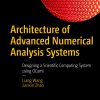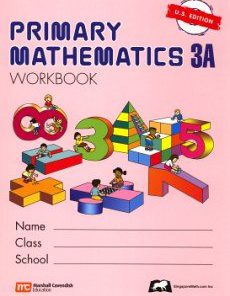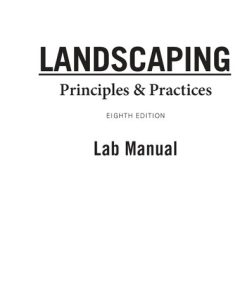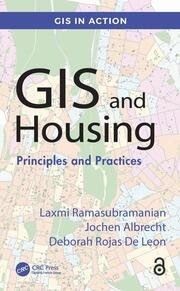Digital Design Principles and Practices 5th Edition by John Wakerly ISBN 9780134460093 013446009X
$50.00 Original price was: $50.00.$25.00Current price is: $25.00.
Digital Design Principles and Practices 5th Edition by John Wakerly – Ebook PDF Instant Download/Delivery: 9780134460093 ,013446009X
Full download Digital Design Principles and Practices 5th Edition after payment

Product details:
ISBN 10: 013446009X
ISBN 13: 9780134460093
Author: John Wakerly
Digital Design Principles and Practices 5th Edition Table of contents:
Chapter 1 Introduction
1.1 About Digital Design
1.2 Analog versus Digital
1.3 Analog Signals
1.4 Digital Logic Signals
1.5 Logic Circuits and Gates
1.6 Software Aspects of Digital Design
1.7 Integrated Circuits
1.8 Logic Families and CMOS
1.9 CMOS Logic Circuits
1.10 Programmable Devices
1.11 Application-Specific ICs
1.12 Printed-Circuit Boards
1.13 Digital-Design Levels
1.14 The Name of the Game
1.15 Going Forward
Drill Problems
Chapter 2 Number Systems and Codes
2.1 Positional Number Systems
2.2 Binary, Octal, and Hexadecimal Numbers
2.3 Binary-Decimal Conversions
2.4 Addition and Subtraction of Binary Numbers
2.5 Representation of Negative Numbers
2.5.1 Signed-Magnitude Representation
2.5.2 Complement Number Systems
2.5.3 Two’s-Complement Representation
*2.5.4 Ones’-Complement Representation
*2.5.5 Excess Representations
2.6 Two’s-Complement Addition and Subtraction
2.6.1 Addition Rules
2.6.2 A Graphical View
2.6.3 Overflow
2.6.4 Subtraction Rules
2.6.5 Two’s-Complement and Unsigned Binary Numbers
*2.7 Ones’-Complement Addition and Subtraction
*2.8 Binary Multiplication
*2.9 Binary Division
*2.10 Binary Codes for Decimal Numbers
2.11 Gray Code
*2.12 Character Codes
2.13 Codes for Actions, Conditions, and States
*2.14 n-Cubes and Distance
*2.15 Codes for Detecting and Correcting Errors
*2.15.1 Error-Detecting Codes
*2.15.2 Error-Correcting and Multiple-Error-Detecting Codes
*2.15.3 Hamming Codes
*2.15.4 CRC Codes
*2.15.5 Two-Dimensional Codes
*2.15.6 Checksum Codes
*2.15.7 m-out-of-n Codes
2.16 Codes for Transmitting and Storing Serial Data
2.16.1 Parallel and Serial Data
*2.16.2 Serial Line Codes
References
Drill Problems
Exercises
Chapter 3 Switching Algebra and Combinational Logic
3.1 Switching Algebra
3.1.1 Axioms
3.1.2 Single-Variable Theorems
3.1.3 Two- and Three-Variable Theorems
3.1.4 n-Variable Theorems
3.1.5 Duality
3.1.6 Standard Representations of Logic Functions
3.2 Combinational-Circuit Analysis
3.3 Combinational-Circuit Synthesis
3.3.1 Circuit Descriptions and Designs
3.3.2 Circuit Manipulations
3.3.3 Combinational-Circuit Minimization
*3.3.4 Karnaugh Maps
*3.4 Timing Hazards
*3.4.1 Static Hazards
*3.4.2 Finding Static Hazards Using Maps
*3.4.3 Dynamic Hazards
*3.4.4 Designing Hazard-Free Circuits
References
Drill Problems
Exercises
Chapter 4 Digital Design Practices
4.1 Documentation Standards
4.1.1 Block Diagrams
4.1.2 Gate Symbols
4.1.3 Signal Names and Active Levels
4.1.4 Active Levels for Pins
4.1.5 Constant Logic Signals
*4.1.6 Bubble-to-Bubble Logic Design
4.1.7 Signal Naming in HDL Models
4.1.8 Drawing Layout
4.1.9 Buses
4.1.10 Additional Schematic Information
4.2 Circuit Timing
4.2.1 Timing Diagrams
4.2.2 Propagation Delay
4.2.3 Timing Specifications
*4.2.4 Sample Timing Specifications
4.2.5 Timing Analysis Tools
4.3 HDL-Based Digital Design
4.3.1 HDL History
4.3.2 Why HDLs?
4.3.3 EDA Tool Suites for HDLs
4.3.4 HDL-Based Design Flow
References
Drill Problems
Exercises
Chapter 5 Verilog Hardware Description Language
5.1 Verilog Models and Modules
5.2 Logic System, Nets, Variables, and Constants
5.3 Vectors and Operators
5.4 Arrays
5.5 Logical Operators and Expressions
5.6 Compiler Directives
5.7 Structural Models
5.8 Dataflow Models
5.9 Behavioral Models (Procedural Code)
5.9.1 Always Statements and Blocks
5.9.2 Procedural Statements
5.9.3 Inferred Latches
5.9.4 Assignment Statements
5.9.5 begin-end Blocks
5.9.6 if and if-else Statements
5.9.7 case Statements
5.9.8 Looping Statements
5.10 Functions and Tasks
5.11 The Time Dimension
5.12 Simulation
5.13 Test Benches
5.14 Verilog Features for Sequential Logic Design
5.15 Synthesis
References
Drill Problems
Exercises
Chapter 6 Basic Combinational Logic Elements
6.1 Read-Only Memories (ROMs)
6.1.1 ROMs and Truth Tables
6.1.2 Using ROMs for Arbitrary Combinational Logic Functions
6.1.3 FPGA Lookup Tables (LUTs)
*6.2 Combinational PLDs
*6.2.1 Programmable Logic Arrays
*6.2.2 Programmable Array Logic Devices
6.3 Decoding and Selecting
*6.3.1 A More Mathy Decoder Definition
6.3.2 Binary Decoders
6.3.3 Larger Decoders
6.3.4 Decoders in Verilog
6.3.5 Custom Decoders
6.3.6 Seven-Segment Decoders
6.3.7 Binary Encoders
6.4 Multiplexing
6.4.1 Gate-Level Multiplexer Circuits
6.4.2 Expanding Multiplexers
6.4.3 Multiplexers, Demultiplexers, and Buses
6.4.4 Multiplexers in Verilog
References
Drill Problems
Exercises
Chapter 7 More Combinational Building Blocks
7.1 Three-State Devices
7.1.1 Three-State Buffers
*7.1.2 Standard MSI Three-State Buffers
7.1.3 Three-State Outputs in Verilog
7.1.4 Three-State Outputs in FPGAs
7.2 Priority Encoding
7.2.1 Cascading Priority Encoders
7.2.2 Priority Encoders in Verilog
7.3 Exclusive-OR Gates and Parity Functions
7.3.1 Exclusive-OR and Exclusive-NOR Gates
7.3.2 Parity Circuits
7.3.3 Parity-Checking Applications
7.3.4 Exclusive-OR Gates and Parity Circuits in Verilog
7.4 Comparing
7.4.1 Comparator Structure
7.4.2 Iterative Circuits
7.4.3 An Iterative Comparator Circuit
7.4.4 Magnitude Comparators
7.4.5 Comparators in HDLs
7.4.6 Comparators in Verilog
7.4.7 Comparator Test Benches
*7.4.8 Comparing Comparator Performance
*7.5 A Random-Logic Example in Verilog
Drill Problems
Exercises
Chapter 8 Combinational Arithmetic Elements
8.1 Adding and Subtracting
8.1.1 Half Adders and Full Adders
8.1.2 Ripple Adders
8.1.3 Subtractors
8.1.4 Carry-Lookahead Adders
8.1.5 Group Ripple Adders
8.1.6 Group-Carry Lookahead
*8.1.7 MSI Arithmetic and Logic Units
8.1.8 Adders in Verilog
*8.1.9 Parallel-Prefix Adders
*8.1.10 FPGA CARRY4 Element
8.2 Shifting and Rotating
8.2.1 Barrel Shifters
8.2.2 Barrel Shifters in Verilog
8.3 Multiplying
8.3.1 Combinational Multiplier Structures
*8.3.2 Multiplication in Verilog
*8.4 Dividing
*8.4.1 Basic Unsigned Binary Division Algorithm
*8.4.2 Division in Verilog
References
Drill Problems
Exercises
Chapter 9 State Machines
9.1 State-Machine Basics
9.2 State-Machine Structure and Analysis
9.2.1 State-Machine Structure
9.2.2 Output Logic
9.2.3 State-Machine Timing
9.2.4 Analysis of State Machines with D Flip-Flops
9.3 State-Machine Design with State Tables
9.3.1 State-Table Design Example
*9.3.2 State Minimization
9.3.3 State Assignment
*9.3.4 Synthesis Using D Flip-Flops
9.3.5 Beyond State Tables
*9.4 State-Machine Design with State Diagrams
*9.4.1 T-Bird Tail Lights Example
*9.5 State-Machine Design with ASM Charts
*9.5.1 T-Bird Tail Lights with ASM Charts
9.6 State-Machine Design with Verilog
References
Drill Problems
Exercises
Chapter 10 Sequential Logic Elements
10.1 Bistable Elements
10.1.1 Digital Analysis
10.1.2 Analog Analysis
10.1.3 Metastable Behavior
10.2 Latches and Flip-Flops
10.2.1 S-R Latch
10.2.2 S ¯ – R ¯ Latch
10.2.3 D Latch
10.2.4 Edge-Triggered D Flip-Flop
10.2.5 Edge-Triggered D Flip-Flop with Enable
10.2.6 T Flip-Flops
10.3 Latches and Flip-Flops in Verilog
10.3.1 Instance Statements and Library Components
10.3.2 Behavioral Latch and Flip-Flop Models
10.3.3 More about clocking in Verilog
10.4 Multibit Registers and Latches
10.4.1 MSI Registers and Latches
10.4.2 Multibit Registers and Latches in Verilog
*10.5 Miscellaneous Latch and Bistable Applications
*10.5.1 Switch Debouncing
*10.5.2 Bus-Holder Circuits
*10.6 Sequential PLDs
10.7 FPGA Sequential Logic Elements
*10.8 Feedback Sequential Circuits
*10.8.1 Basic Analysis
*10.8.2 Analyzing Circuits with Multiple Feedback Loops
*10.8.3 Feedback Sequential-Circuit Design
*10.8.4 Feedback Sequential Circuits in Verilog
References
Drill Problems
Exercises
Chapter 11 Counters and Shift Registers
11.1 Counters
11.1.1 Ripple Counters
11.1.2 Synchronous Counters
11.1.3 A Universal 4-Bit Counter Circuit
11.1.4 Decoding Binary-Counter States
11.1.5 Counters in Verilog
11.2 Shift Registers
11.2.1 Shift-Register Structure
11.2.2 Shift-Register Counters
11.2.3 Ring Counters
*11.2.4 Johnson Counters
11.2.5 Linear Feedback Shift-Register Counters
11.2.6 Shift Registers in Verilog
11.2.7 Timing-Generator Examples
11.2.8 LFSR Examples
*11.3 Iterative versus Sequential Circuits
References
Drill Problems
Exercises
Chapter 12 State Machines in Verilog
12.1 Verilog State-Machine Coding Styles
12.1.1 Basic Coding Style
12.1.2 A Verilog State-Machine Example
12.1.3 Combined State Memory and Next-State Logic
12.1.4 Reset Inputs
12.1.5 Pipelined Moore Outputs in Verilog
12.1.6 Direct Verilog Coding Without a State Table
*12.1.7 State-Machine Extraction
12.2 Verilog State-Machine Test Benches
12.2.1 State-Machine Test-Bench Construction Methods
12.2.2 Example Test Benches
12.2.3 Instrumenting Next-State Logic for Testing
12.2.4 In Summary
12.3 Ones Counter
12.4 Combination Lock
12.5 T-Bird Tail Lights
12.6 Reinventing Traffic-Light Controllers
12.7 The Guessing Game
*12.8 “Don’t-Care” State Encodings
12.9 Decomposing State Machines
12.9.1 The Guessing Game Again
12.10 The Trilogy Game
References
Drill Problems
Exercises
Chapter 13 Sequential-Circuit Design Practices
13.1 Sequential-Circuit Documentation Practices
13.1.1 General Requirements
13.1.2 Logic Symbols
13.1.3 State-Machine Descriptions
13.1.4 Timing Diagrams and Specifications
13.2 Synchronous Design Methodology
13.2.1 Synchronous System Structure
13.2.2 A Synchronous System Design Example
13.3 Difficulties in Synchronous Design
13.3.1 Clock Skew
13.3.2 Gating the Clock
13.3.3 Asynchronous Inputs
13.4 Synchronizer Failure and Metastability
13.4.1 Synchronizer Failure
13.4.2 Metastability Resolution Time
13.4.3 Reliable Synchronizer Design
13.4.4 Analysis of Metastable Timing
13.4.5 Better Synchronizers
13.4.6 Other Synchronizer Designs
13.5 Two-Clock Synchronization Example
References
Drill Problems
Exercises
14 Digital Circuits
14.1 CMOS Logic Circuits
14.1.1 CMOS Logic Levels
14.1.2 MOS Transistors
14.1.3 Basic CMOS Inverter Circuit
14.1.4 CMOS NAND and NOR Gates
14.1.5 Fan-In
14.1.6 Noninverting Gates
14.1.7 CMOS AND-OR-INVERT and OR-AND-INVERT Gates
14.2 Electrical Behavior of CMOS Circuits
14.2.1 Overview
14.2.2 Data Sheets and Specifications
14.3 CMOS Static Electrical Behavior
14.3.1 Logic Levels and Noise Margins
14.3.2 Circuit Behavior with Resistive Loads
14.3.3 Circuit Behavior with Nonideal Inputs
14.3.4 Fanout
14.3.5 Effects of Loading
14.3.6 Unused Inputs
14.3.7 How to Destroy a CMOS Device
14.4 CMOS Dynamic Electrical Behavior
14.4.1 Transition Time
14.4.2 Propagation Delay
14.4.3 Power Consumption
*14.4.4 Current Spikes and Decoupling Capacitors
*14.4.5 Inductive Effects
*14.4.6 Simultaneous Switching and Ground Bounce
14.5 Other CMOS Input and Output Structures
14.5.1 Transmission Gates
14.5.2 Schmitt-Trigger Inputs
14.5.3 Three-State Outputs
*14.5.4 Open-Drain Outputs
*14.5.5 Driving LEDs and Relays
*14.5.6 Multisource Buses
*14.5.7 Wired Logic
*14.5.8 Pull-Up Resistors
14.6 CMOS Logic Families
14.6.1 HC and HCT
14.6.2 AHC and AHCT
*14.6.3 HC, HCT, AHC, and AHCT Electrical Characteristics
*14.6.4 AC and ACT
*14.6.5 FCT and FCT-T
14.7 Low-Voltage CMOS Logic and Interfacing
*14.7.1 3.3-V LVTTL and LVCMOS Logic Levels
*14.7.2 5-V Tolerant Inputs
*14.7.3 5-V Tolerant Outputs
*14.7.4 TTL/LVTTL Interfacing Summary
*14.7.5 Logic Levels Less Than 3.3 V
14.8 Differential Signaling
References
Drill Problems
Exercises
Chapter 15 ROMs, RAMs, and FPGAs
15.1 Read-Only Memory
15.1.1 Internal ROM Structure
15.1.2 Two-Dimensional Decoding
15.1.3 Commercial ROM Types
15.1.4 Parallel-ROM Interfaces
*15.1.5 Parallel-ROM Timing
15.1.6 Byte-Serial Interfaces for NAND Flash Memories
*15.1.7 NAND Memory Timing and Access Bandwidth
*15.1.8 Storage Management for NAND Memories
15.2 Read/Write Memory
15.3 Static RAM
15.3.1 Static-RAM Inputs and Outputs
15.3.2 Static-RAM Internal Structure
*15.3.3 Static-RAM Timing
*15.3.4 Standard Asynchronous SRAMs
*15.3.5 Synchronous SRAM
15.4 Dynamic RAM
15.4.1 Dynamic-RAM Structure
15.4.2 SDRAM Timing
15.4.3 DDR SDRAMs
15.5 Field-Programmable Gate Arrays (FPGAs)
15.5.1 Xilinx 7-Series FPGA Family
15.5.2 CLBs and Other Logic Resources
15.5.3 Input/Output Block
15.5.4 Programmable Interconnect
References
Drill Problems
Exercises
INDEX
People also search for Digital Design Principles and Practices 5th Edition:
digital system design syllabus 2021 regulation
digital design 3512
digital design 3512 subwoofer
digital design 3d printing
digital design 3d
Tags: John Wakerly, Digital Design, Principles, Practices
You may also like…
Computers
Principles of Verilog Digital Design 1st Edition by Wen-Long Chin 9781000519235 1000519236
Uncategorized
Uncategorized
Uncategorized
Engineering - Civil & Structural Engineering
GIS and Housing: Principles and Practices 1st Edition Laxmi Ramasubramanian











